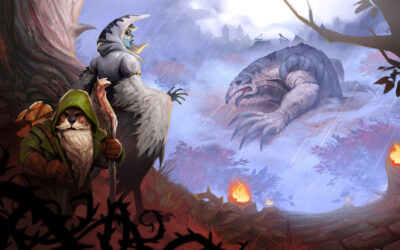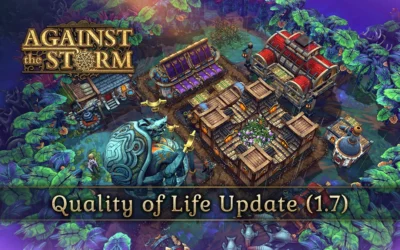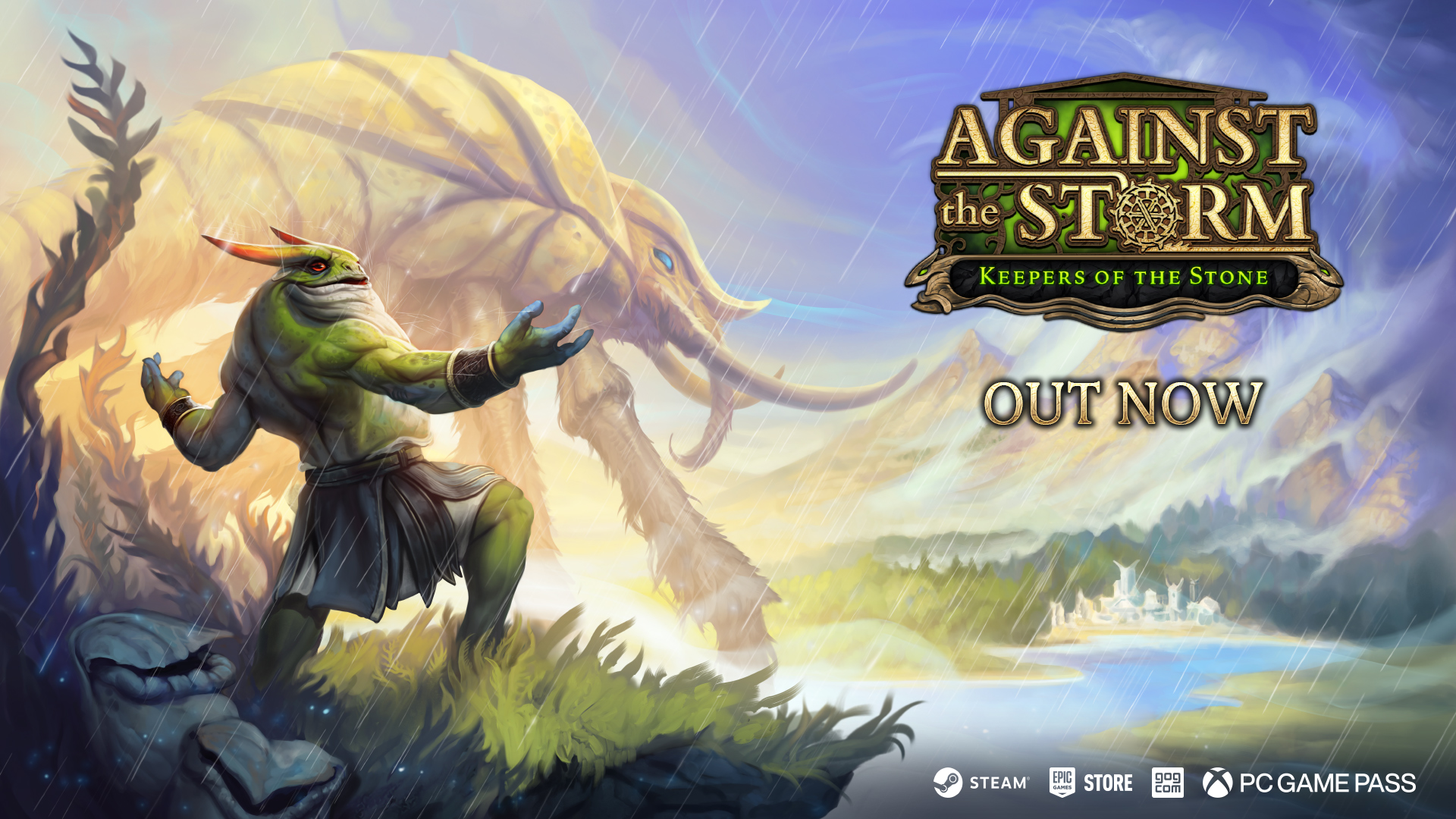
Keepers of the Stone DLC and Fishing Update (1.4) available!
Greetings, Viceroys!
The wait is finally over! Sturdy-as-stone Frogs join Against the Storm as the 6th playable species, while the new biome – Coastal Grove – opens its port to Viceroys searching for sunken treasures.
We also released Fishing Update (1.4), free for everyone, which introduces a new fishing system, passive need bonuses, new buildings, increased level cap, and many many more changes.
As today’s notes are pretty lengthy, you can use the table of contents below to jump to specific sections easily:
- Keepers of the Stone DLC Changelog
- Developer notes
- Fishing Update (1.4) Changelog
- Settlement Saves & Legacy Branch 1.3
KEEPERS OF THE STONE CHANGELOG
As the struggle for survival against the Blightstorm continues, Against the Storm – Keepers of the Stone introduces a new species, a new biome, and a selection of new buildings, orders, risks, and opportunities for any Viceroy up for the challenge.
Watch the new Gameplay Trailer for an overview of the major new features:
Check out the full list of Keepers of the Stone changes:
- Added a new species – Frogs.
- Frogs are dignified and proud people with a unique affinity for wealth, renowned for their exceptional skills in architecture and their love of water. They seem to be the least bothered by rain and prefer not to live in ordinary shelters. Frogs are skilled masons and love working with rainwater.
- Frogs have the following needs:
- Paste
- Biscuits
- Pie
- Boots
- Religion
- Luxury
- Brawling
- Frog Housing
- Frogs can’t live in shelters and don’t have a need for Basic Housing
- Frog specializations are masonry (proficiency) and rainwater (comfort).
- Frog firekeepers have the ability to increase the speed at which newcomers arrive by 50%.
- Frog Houses have 4 upgrade levels instead of 2.
- Level 1
- Extra Room – A strategically built wall can do wonders. This house will have room for one additional villager.
- Rainwater Storage – Frogs love to bathe. They use specially treated and purified rainwater to do so. Increases the tank capacity for each type of rainwater by 50.
- Level 2
- Indoor Pool – This seemingly extravagant luxury is something that Frogs need to survive. Villagers living in a house with this upgrade receive an additional +2 to Resolve.
- Drafting Table – Frogs are natural architects. They are said to have designed most of the Smoldering City. Building materials are produced 3% faster for each villager living in a house with this upgrade.
- Level 3
- Atrium – Frogs form very tight-knit communities and highly value their social status. Each newcomer group has 1 additional villager for every 2 villagers living in a house with this upgrade.
- Storage Room – Although Frogs are generally considered to be greedy, they can sometimes be generous. At the start of each Drizzle, gain 1 Pack of Building Materials for each villager living in a house with this upgrade.
- Level 4
- Water Pipeline – An advanced system of pipes connecting buildings that use rainwater. The “Low Strain” bonus from Rain Engines gives an additional +1 to Resolve for every 2 villagers living in a house with this upgrade.
- Workbench – An essential piece of furniture in every Fog household. Building material recipes have a 3% higher chance of producing extra resources for each villager living in a house with this upgrade.
- Level 1
- Frogs’ starting ability is locating one nearby ruin.
- Frogs have the following attributes:
- Initial Resolve: 10
- Break interval: 2m 30s
- Resilient: medium
- Demanding: 25
- Decadent: 5
- Hunger tolerance: 5
- Frogs are unlocked by reaching level 13.
- Because housing is such a crucial element of the Frog species, essential Frog Houses are automatically unlocked after reaching level 13 (instead of being an upgrade in the Citadel, like in the case of all other species).
- Added a new biome to the game – the Coastal Grove.
- Coastal Grove – These lands have been underwater for a very long time, and a dense forest of algae has grown over them. The seawater has blocked any Viceroys that have tried to reach this area, so the nearby marshes are full of remnants of earlier settlements.
- In the Coastal Grove, your settlement will start at the edge of the map, near the water.
- Your starting glade in the Coastal Gove will contain a new unique building – the Strider Port.
- Strider Port – From this ancient port, expeditions can be launched to search the nearby swamps for blueprints and treasure in the submerged ruins of former settlements.
- Expeditions alternate between two types: blueprint expeditions and treasure expeditions. Blueprint expeditions give you a blueprint and a treasure chest, while treasure expeditions offer only a treasure chest, but with a higher chance of higher rarity.
- To send an expedition, you need to provide food for the Water Strider (Fish or Algae) and for its riders (a choice of raw or cooked food).
- You can invest more supplies in an expedition to increase your chances of getting a higher rarity treasure chests.
- The Coastal Grove is a remote location that is difficult for royal envoys to reach. As a result, you’ll get fewer reputation blueprints in this biome.
- To make up for this, you will be sending out Strider expeditions to look for blueprints. There are 5 fewer blueprints you can get from reputation, but a total of 8 blueprints you can get from expeditions.
- Before sending an expedition in search of a blueprint, you can select the building category you are interested in.
- Each subsequent expedition will be a bit more expensive and time-consuming.
- Trees in the Coastal Grove have a chance to drop Algae (30%) and Vegetables (10%).
- Resources in the Coastal Grove:
- Berries
- Roots
- Insects
- Fish
- Algae
- Scales
- Reeds
- Clay
- Coal
- The Coastal Grove also has an additional effect (aside from the Strider Port).
- Gift of the Depths – After using bait 150 times in your fishing huts, you will unlock the ability to sacrifice Algae in the Ancient Hearth to reduce Hostility.
- Added 4 new buildings to the game
- Pantry
- Can produce: Pie (T2), Porridge (T2), Pack of Luxury Goods (T2)
- Can use: Drizzle Water
- Specialization: farming
- Species locked: Frogs
- Cannery
- Can produce: Paste (T3), Wine (T2), Biscuits (T1)
- Can use: Drizzle Water
- Species locked: Frogs
- Frog House – Building specifically made for Frogs. Has to be built near a Hearth. Can house 2 residents.
- Species locked: Frogs
- Strider Port – From this ancient port, expeditions can be launched to search the nearby swamps for blueprints and cornerstones in the submerged ruins of former settlements.
- Only available in the new Coastal Grove biome.
- Added 2 rewards to the upgrade tree in the Smoldering City.
- House Upgrades: Frogs – Unlocks the ability to upgrade Frog Houses.
- Starting Ability: Frogs – Unlocks the Starting Ability of the species: Frogs. Reveals the location of the nearest ruin.
- Added 3 new Legendary Cornerstones and 2 Rare perks.
- Borrowed Time (Legendary, yearly) – The Queen looks more favorably upon a city represented by such distinguished ambassadors. Each fully upgraded house will grant you seconds of Grace Period after Impatience reaches its maximum threshold.
- Strength in Numbers (Legendary, yearly) – The storm seems less threatening in a populated settlement. Global Resolve drops 5% slower for every Frog villager.
- City of Wonders (Legendary, yearly) – Members of the Frog Clan flock to you settlement. Gain 1 Frog villager for every 2 house upgrades.
- Frog Friendship (Rare, orders) – 2 additional Frogs will come with each group of newcomers.
- Frog Clan Support (Rare, orders) – Ever since the Great Civil War, all species have been locked in a constant struggle to gain the Queen’s favor. The Frogs remember your help. (+3 to Frogs Resolve)
- Added 12 new Orders:
- The Collegium
- Objective: reach 16/18/20 Frog Resolve
- Reward: 2 Frogs, 20 Fish, 3 Parts
- Joyful Frogs (timed, 7m30s)
- Objective: reach 18/20/22 Frog Resolve
- Reward: Fish Delivery Line, 15 Pipes, 3 Frogs
- Architects
- Objective: have 6 Frogs
- Reward: Brickyard Blueprint, 25 Scales
- Aid for the Frog Clan
- Objective: deliver 3/4/5 Packs of Building Materials and 30/40/50 rainwater
- Reward: 3 Frogs, Frog Faction Support, 3 Parts
- Frog Influx
- Objective: deliver 30/35/60 Stones
- Reward: 5 Frogs, Reinforced Brick Mold, 25 Boots
- Happy Frogs
- Objective: reach 20/22/24 Frog Resolve and use 25/50/75 rainwater
- Reward: Frog Friendship, 30 Paste, Stamping Die
- Frog Population
- Objective: have 8/10/12 Frogs and reach 20/24/28 Frog Resolve
- Reward: Cannery Blueprint, 30 Paste, 5 Parts
- Frog Colony (timed, 8m)
- Objective: have 6/8 Frog Houses
- Reward: Stone Delivery Line, 40 Paste, 5 Frogs
- Frog Relatives
- Objective: fulfill the need for Paste 30/40/50 times and have 4/6/8 Frog Houses
- Reward: Frog Faction Support, 5 Frogs, 35 Boots
- Frog Resolve
- Objective: reach 22/26/30 Frog Resolve
- Reward: Steel Pickaxes, 4 Frogs, 40 Wine
- Frog Majority
- Objective: have 16/18/22 Frog villagers
- Reward: Steel Grater, Wide Nets, 20 Bricks
- Upgraded Living
- Objective: upgrade 4 Frog Houses to level 1/2/3
- Reward: Rainwater Condenser, 3 Frogs, 30 Incense
- The Collegium
- Added a new Glade Event.
- Fallen Frog Architects – A group of fallen Frog architects. It seems they were in the middle of building some sort of monument. The mere sight of these bodies causes unrest among the Frog population.
- Added a new need:
- Frog Housing – Frogs are at home in water. Frog Houses are required to fulfill this need.
- Added 9 new Deeds:
- Frog Settlement – Win a game with at least 30 Frogs.
- Frog Utopia (achievement) – Win a game with 40 Frogs, 20 x Frog Houses, 1 x Forum.
- The Coastal Grove (achievement) – Win a game on the Coastal Grove biome.
- Salty Breeze – Win a game in the Coastal Grove biome, and on Viceroy difficulty (or higher).
- Strider Rider – (achievement) Send out 100 expeditions in the Coastal Grove.
- The Search Continues (achievement) – Send out 12 expeditions in one game in the Coastal Grove.
- Feeling Lucky – (achievement) Obtain the Homestead and Rainpunk Foundry blueprints from expeditions in the Coastal Grove (in one game).
- It’s Wednesday – (achievement) Win a game with Frogs on a Wednesday.
- Frog Republic – (achievement) Upgrade 12 Frog Houses to the maximum level in one game.
- Added 5 new decorations.
- Stone Fence – 1×1 comfort decoration. Unlocked by completing the Frog Population deed.
- Stone Fence Corner – 1×1 comfort decoration. Unlocked by completing the Frog Utopia deed.
- Saltwater Pitcher Plant – 1×1 aesthetics decoration. Unlocked by completing the Salty Breeze deed.
- Evergreen Shrub – 1×1 aesthetics decoration. Unlocked by completing the The Search Continues deed.
- Water Shrine – 3×3 aesthetics decoration. Unlocked by completing the Feeling Lucky deed.
- Changed the default main menu skin to show the new biome.
- Added 14 new music tracks available exclusively in the new Coastal Grove biome.
- Pantry
P.S. One of the best things you can do to help indie games is to leave a Steam review. Once you get a chance to play Keepers of the Stone DLC, we’d love to hear any feedback, positive or negative. Thanks!
You can also get it in the “Complete the set” bundle with the base game and save even more:
DEVELOPER NOTES
Update 1.4, along with the Keepers of the Stone DLC, is the biggest content drop we’ve ever done for Against the Storm, so there’s a lot to unpack here. In this developer notes section, we’ll focus on why certain changes made it into the game and how they’ll affect the overall gameplay. We’re not going to go into detail about every single addition or improvement however, so if you want to read the full breakdown of each and every change, please refer to the two changelogs in this article – one for the DLC content and one for the 1.4 Fishing Update.
Frogs
The most important addition in the Keepers of the Stone DLC is of course the new playable species – Frogs. From the very beginning we wanted to find a good design space for them, a niche they could occupy, rather than just adding a new graphical variant of the same villagers (or even worse – just a better, overpowered version of an existing species). So we decided to go with a species that is more focused on supporting the settlement and helping it grow faster.
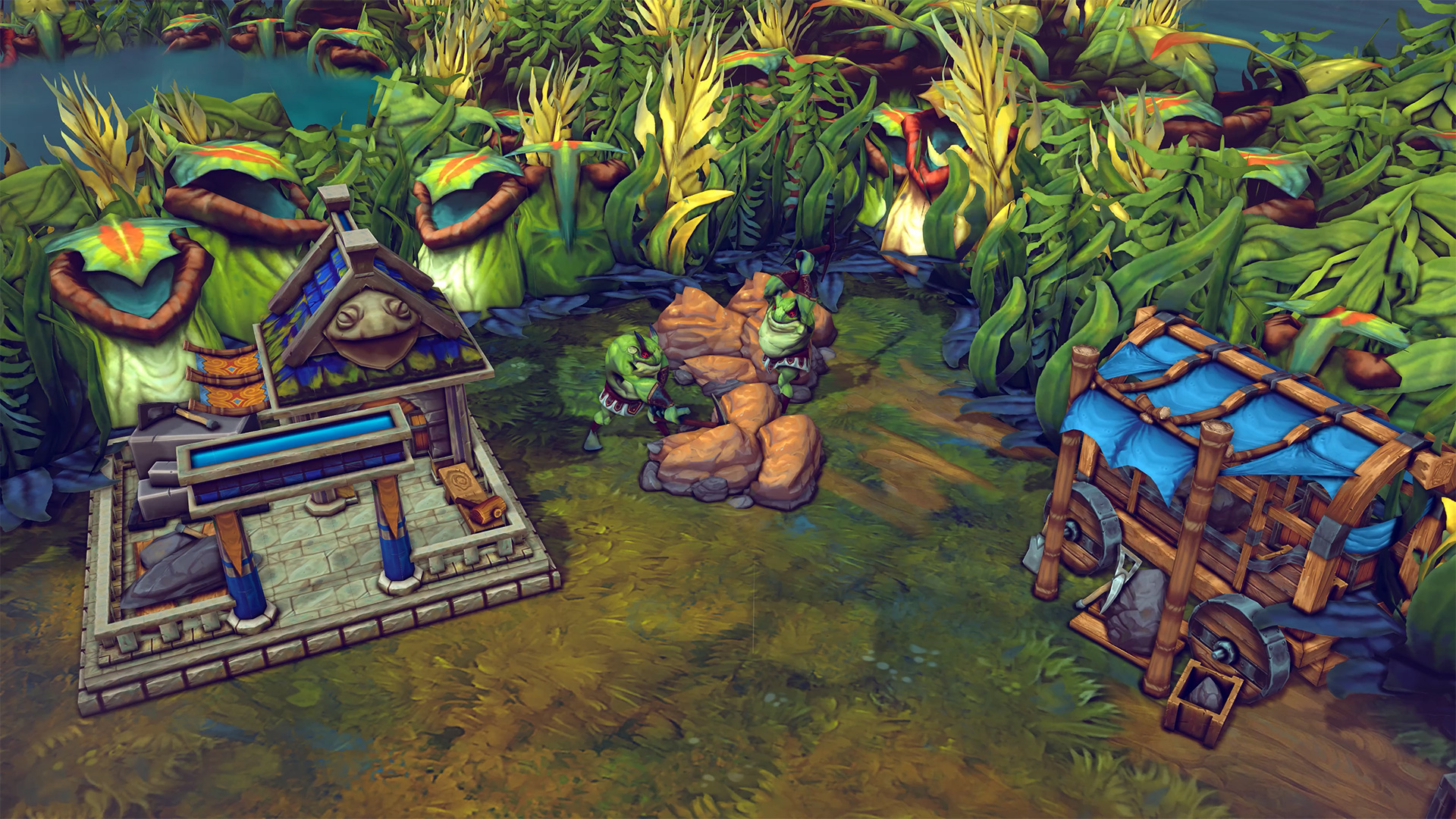
Based on this, and after looking at the game for areas where we felt something was missing from a balance standpoint, we gave Frogs the Masonry specialization, tying them heavily into the stone/brick economy. For their second specialization (comfort), we chose Rainwater, which we took away from Foxes (more on that later). We did this mostly because it fit them thematically, and we wanted to tie Frogs a bit into the Rainpunk branch of the game as well.
This, combined with their starting ability (revealing a ruin in the nearest glade), their unique Resolve profile, their needs makeout, and the Firekeeper passive (increased newcomer arrival speed), began to form a promising new playstyle. However, we still felt that this was not enough to truly differentiate Frogs, so we decided to experiment a bit more.
As Frogs became more and more about building, constructing, and growing your settlement, we naturally felt that they should have some unique interactions with housing. After a while, we came to the conclusion that we could use house upgrades as a good way to add more character and variety to the new species. That’s why Frogs have 4 levels of upgrades (instead of 2), and each level has two unique effects that can either enhance or slightly change the way you play with them.
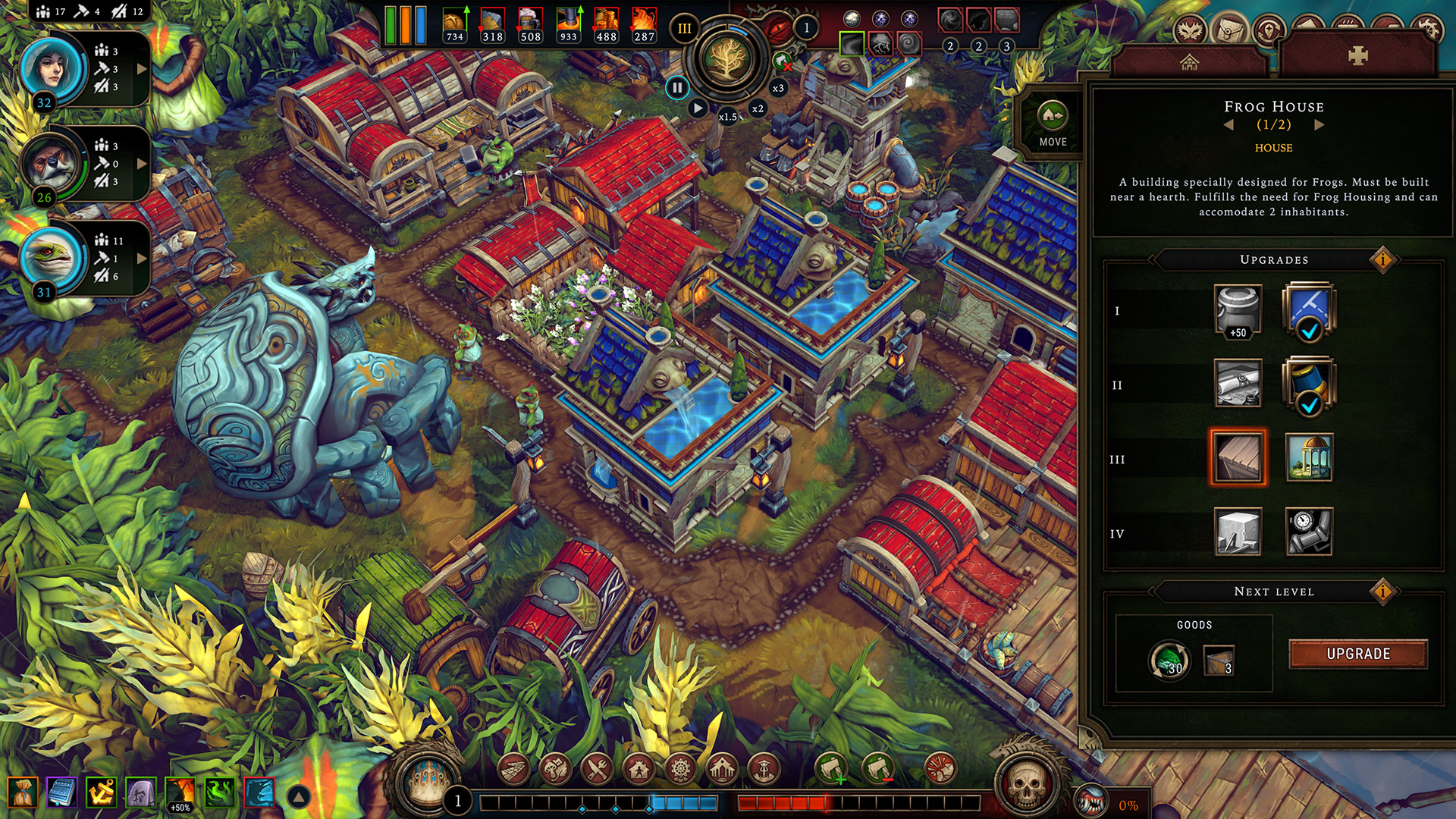
This led us to another idea that we wanted to explore – since we wanted to add a little downside to Frogs, and they are so closely tied to houses, maybe they should lack a basic housing need. As it turned out, this small change affected their entire needs makeup and changed how they performed in the early game, as well as added some unique flavor – the stubborn Frogs just don’t want to live in basic shelters.
There is one more thing to talk about when it comes to new species in Against the Storm. Over the past few months, a number of players have expressed concern that adding new buildings to the game would only dilute the blueprint pool and make the RNG worse than it already is in some cases. And we agree – this is a very valid concern.
So with Update 1.4, we’ve made some tweaks to the blueprint drafting system and increased the number of buildings locked behind each species. This should result in the overall blueprint pool feeling less bloated, as even with the newly added buildings, the number of possible choices has decreased slightly (by 1 or 2 per game).
The Coastal Grove
The other big addition that comes with the DLC is the new biome – the Coastal Grove. It’s a strange tropical land overgrown with giant Kelpwood trees and algae. Any settlement you start here will begin at the edge of the map, right next to the water. There you will find an ancient Strider Port from which you can send out expeditions in search of treasure and blueprints.
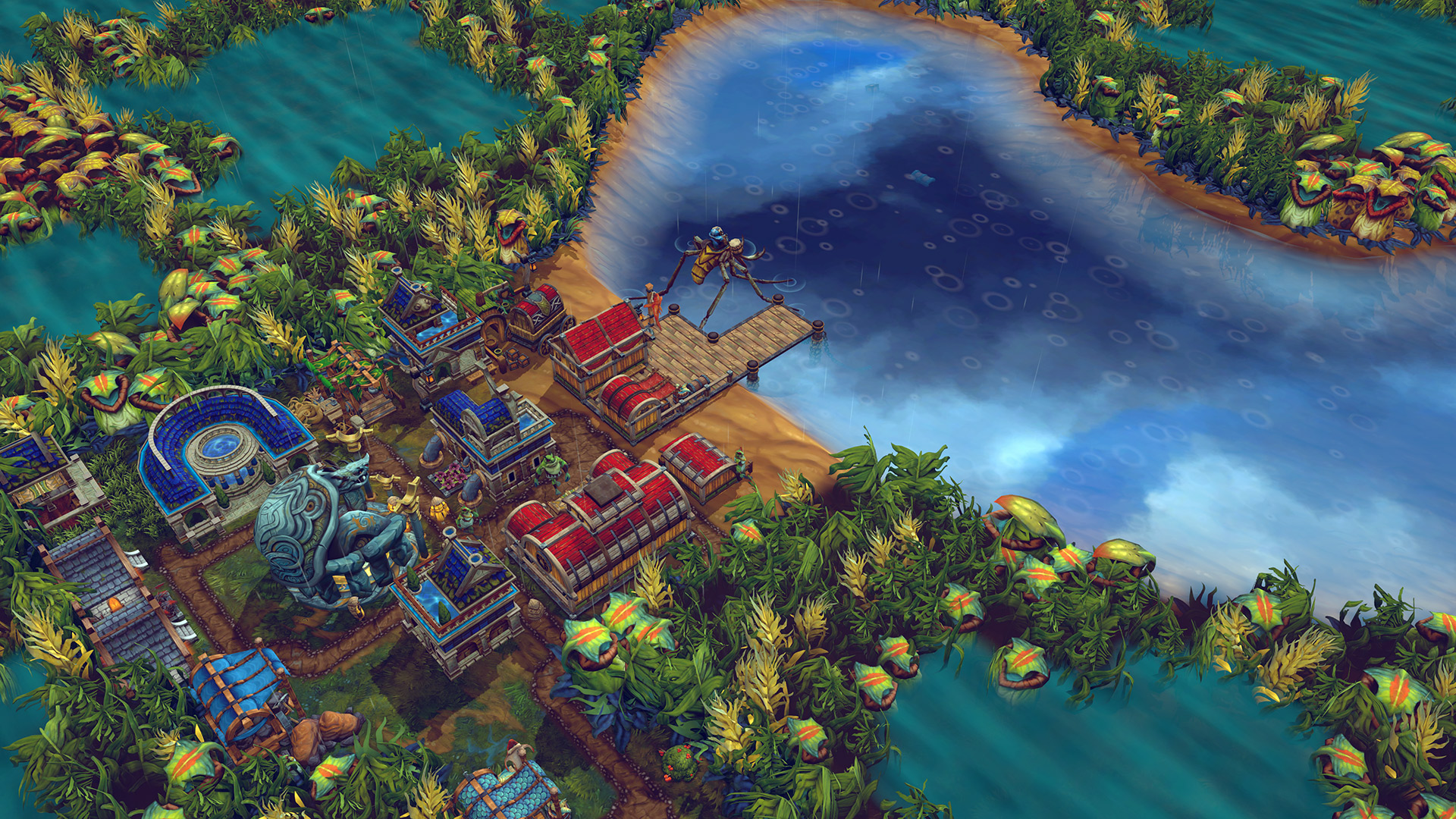
The blueprints from expeditions will come in handy, as you will get fewer of them from the Royal Envoy in this harsh land. However, the upside is that you will be able to choose the category of building you want before sending an expedition. All in all, even with fewer reputation rewards, you will still be able to get more blueprints than usual – your acquisition method will just be different (timed differently, as well as costing you some resources).
When we were designing the Coastal Grove, we were thinking about areas of the game that were underutilized or lacked some “rule-bending”, and we quickly came to the conclusion that there was a lot of potential in blueprint acquisition. Sure, sometimes we give you more or less choices per reputation point, or sometimes we allow you to pick a building with a wildcard, but compared to other systems in the game, there just wasn’t that much variety. Add to that the visual flair of a large beast of burden swimming around the map in search of blueprints and treasure, and we quickly knew that this was the right direction.
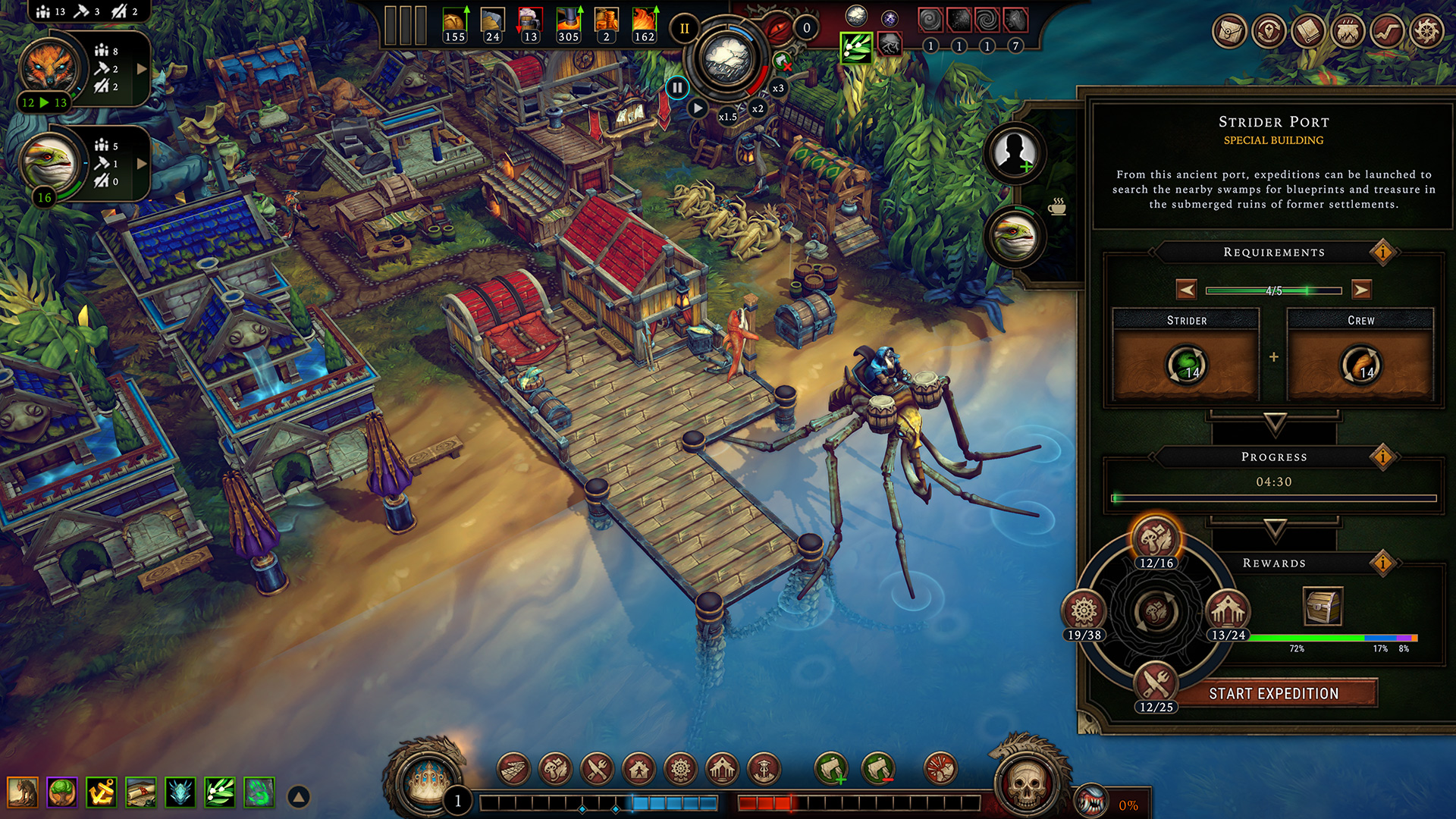
With this new biome, we also wanted to push the gameplay a bit more into the newly introduced fishing system. That’s why it has a strong focus on the new resource – algae – as well as all three types of ponds (fish, algae, and scales). It also has a unique biome effect called Gift of the Depths, which allows players to sacrifice algae in the Ancient Hearth for a Hostility reduction bonus after using enough bait while fishing.
Speaking of which…
Fishing
Fishing is the new resource acquisition system coming in 1.4, and it’s available to all players, whether you own the Keepers of the Stone DLC or not. It works in a similar way to regular camp gathering. There are two types of fishing huts: small and regular. The small one is an essential building, and the regular one must be acquired separately (as a blueprint choice, from a trader, or via a wildcard).
There is one small difference, however – fishermen don’t just collect resources one by one. They first catch fish and algae in nets, and then transport them directly to a warehouse when the entire pond is depleted. Resources held in nets are not available for production or consumption and must first be transported to a warehouse. You can decide to reel in a net sooner, but once you do this, the pond is depleted.
Ponds have a very large number or resource charges in them when compared to other does (60 as opposed to 20 in small ones). The intention here was to create a new type of resource gathering mechanism – a mix of a non-renewable source (just like regular deposits) and a big time investment with a big payoff at the end (like farming). To mix things up a bit, there’s also the option of using ground bait to double the potential fishing yield.
Ground bait is made from Packs of Crops, directly at the fishing hut, and one pack equals five pieces of bait. We decided to use this resource here because it was the only item in the “Packs” category that didn’t have a clear role outside of order fulfillment (all the others have at least one other sink or way of using them).
With the addition of fishing and all the new goods, we had to adjust the distribution of resources in all biomes. Most of them got an extra pond or two to make fishing a viable option, but some, like the Marshlands, underwent a major transformation. The addition of more elements to the node pool made this biome particularly susceptible to fiber shortages, so we decided to increase the spawn rate of stone/fiber nodes, and we changed the stone node from a regular one to an “overgrown” variant, which has an increased chance of dropping algae.
But this is just one of the many balance changes we made in Update 1.4. In the next part of this note, we will go into more detail about some of the major adjustments and improvements.
Balance
With all this new content added to the game, a lot of the balance had to change to not only make room for the new species and resources, but also to make sure that all of these new elements were fun to play with. As a result, we reshuffled the needs of nearly every species, rebalanced a lot of buildings, updated a number of recipes, changed leveling unlocks, added new citadel upgrades, and much, much more.
For example, one of the bigger changes to the needs was the addition of a new clothing item – Boots. We wanted to make sure that every species in the game had at least one clothing need, so that there could be more seasonal effects and perks tied to clothing. Also, this one category of needs has always felt very underwhelming, and we wanted to make it a little more important, especially since the game is about surviving harsh weather conditions.
Another major change is the addition of need-based passive effects. From now on, fulfilling a complex food, clothing, or service need will grant a buff to the affected villager. For example, eating complex food will increase the chance of producing double yields, while wearing boots will make a villager faster.
With this new system, we tried to solve, or at least alleviate, a few problems at once. The first problem was that very often the use of complex food or service items felt like a complete waste if it didn’t result in reputation generation. This breaks the promise the game makes to the player: you will take care of your little ones, and it will feel rewarding. While we want to leave some ambiguity here for the most dedicated players, we want regular players to feel rewarded for making the villagers happy – for consuming goods even if it does not contribute to reputation (especially the service-related ones).
The second problem is more related to the arrival of Frogs and the inevitable expansion of the needs pool. In almost every game, players will now form production chains that only affect 1/3 of their population. This feels much less rewarding than 2/3 or even 3/3 combos, which are still possible, but much less likely. So again, we are trying to make completing production chains more rewarding.
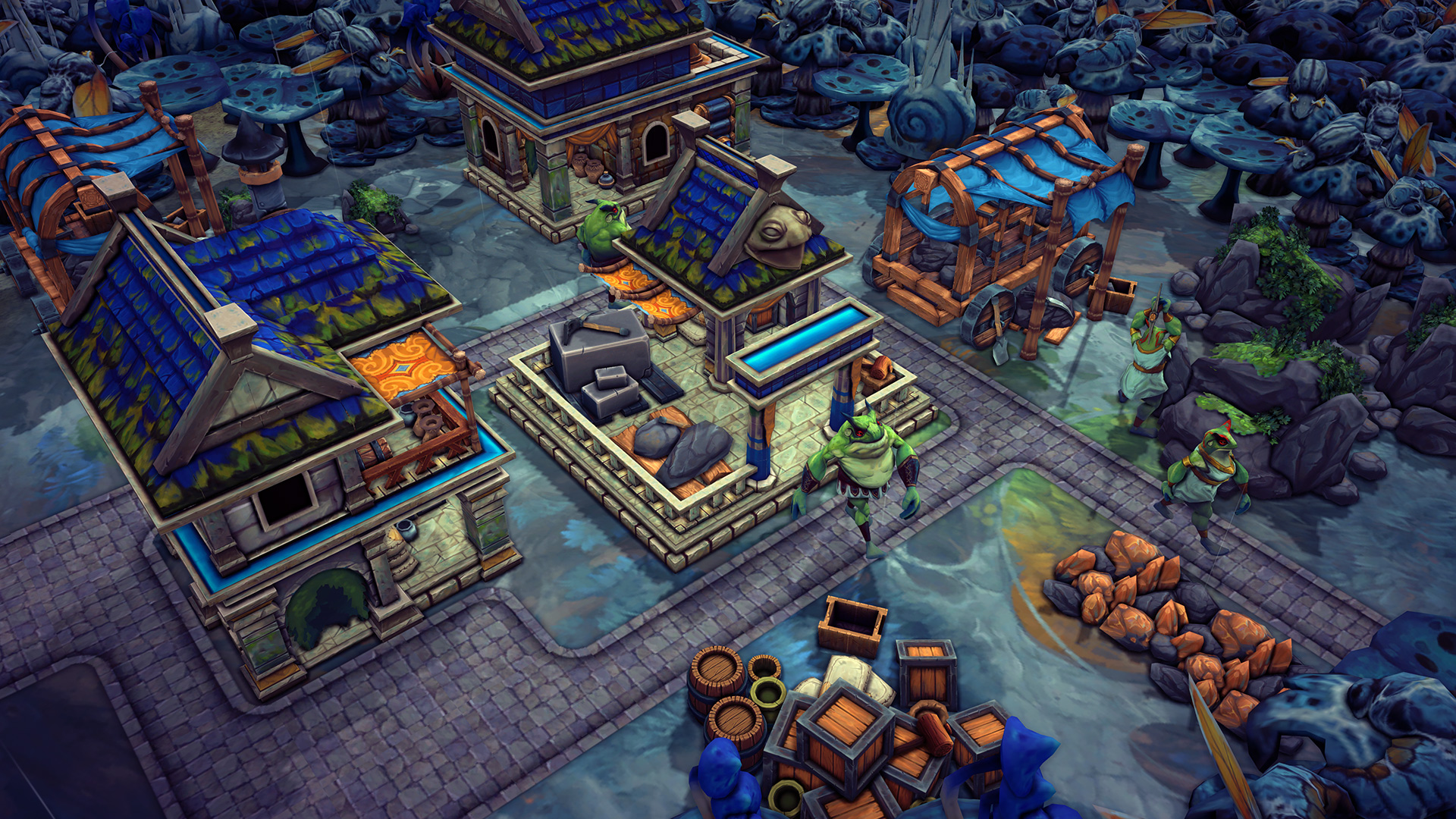
We also hope that the addition of strong passive effects to needs will influence the purposeful starvation strategy (or at least make it a bit less dominant). In the ideal scenario, purposeful starvation and hoarding would be just one out of several available strategies, not the only viable way to play high prestige. While those changes alone won’t make it happen, they should be a step in that direction.
Yet another big change, especially for more advanced players, is the rebalancing of the Field Kitchen. It used to produce Jerky and Porridge, but we replaced these recipes with Paste (a new good) and Skewers. As a result, the Field Kitchen now produces Biscuits, Pickled Goods, Paste, and Skewers.
In deciding which 3 or 4 recipes should be available in the Field Kitchen (if any should, to be honest), we’ve redefined the role of this building and its T0 recipes. In our opinion, Field Kitchen should lower the risk of taking buildings with recipes for semi-finished goods, used to make Complex Food. It should not be a small factory for Jerky and Porridge, but a building that rewards players for taking risks – for making flour, containers, or dye early on.
These are just some of the bigger changes coming in update 1.4. There are also the aforementioned new goods (scales, fish, algae, boots, paste), new nodes (fish ponds, leather), the reshuffling of resources in the biomes, which we already touched upon, and some significant specialization changes – such as the Foxes losing their Rainwater specialization and gaining a comfort bonus when working in buildings infected with Blightrot.
This specialization change for Foxes is something we wanted to try for a long time, but never really had the time to implement. It fits the flavor of the species, as lore-wise Foxes live in a symbiotic relationship with Blightrot, but it also adds a new gameplay dimension. It’s technically a nerf, but it also reinforces the corruption-heavy playstyle we’ve been trying to achieve over the last few updates, and it creates potential synergies with other species/perks.
All balance changes in this note and the changelog will be in version 1.4, whether you own the Keepers of the Stone DLC or not. Against the Storm is highly interconnected, so having separate versions isn’t practical. We’ve worked hard to ensure that the experience is as good or better than in version 1.3, whether or not you have the DLC. Many changes weren’t just to add new content but also to improve the game’s overall pacing and polish.
However, if you find that you don’t want to play after the 1.4 update, and that you prefer the pre-DLC, vanilla feel of Against the Storm, you can freely switch back to the 1.3 version at any time using the beta branch feature that Steam provides. Please see the “Settlement Savings & Legacy Branch” section below for more information.
UX and miscellaneous changes
Aside from the new content and balance changes, there are also a number of smaller features and general improvements coming with Update 1.4. Most of these were inspired by the community, and all of them are available to everyone after the 1.4 update – DLC owners or not.
First, let’s talk about the changes to the in-game encyclopedia. Many of you will be happy to know that we’ve finally added the “Glade Events” category! In it, you can browse events at your leisure, look up their requirements, see their potential rewards, etc. There’s a catch, though – when we designed this feature, we didn’t want to spoil everything right away, and we also wanted to introduce a bit of a scavenger hunt into the system. That’s why events are locked at first, and must be solved at least once to be visible in the encyclopedia (the only exception is the Queen’s Hand Trial, where all events are visible from the start).
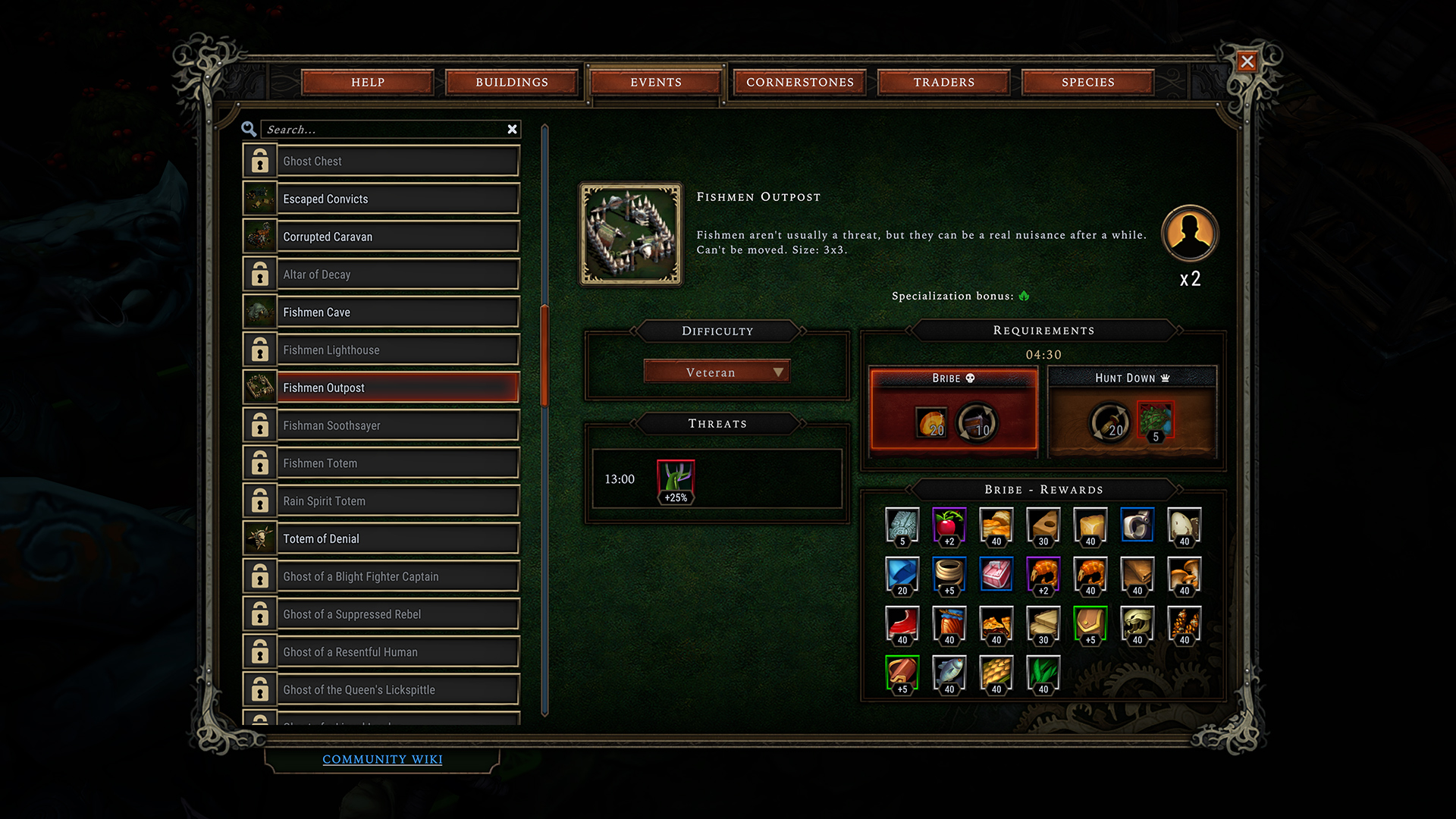
In addition, we have added special markers to events and buildings in the encyclopedia to indicate which ones are locked behind a particular species (so they won’t appear if the species is not present in your settlement). This information is also available in the species tab of the encyclopedia.
We have done a major under-the-hood overhaul of the entire villager behavior system. While this change is mostly invisible to the naked eye, it has allowed us to finally implement some long-awaited features requested by the community, such as the ability to list Purging Fire in the recipe panel, builders and blight fighters taking resources from nearby buildings, farmers building fields, or the ability to assign workers to unfinished construction sites to serve as builders.
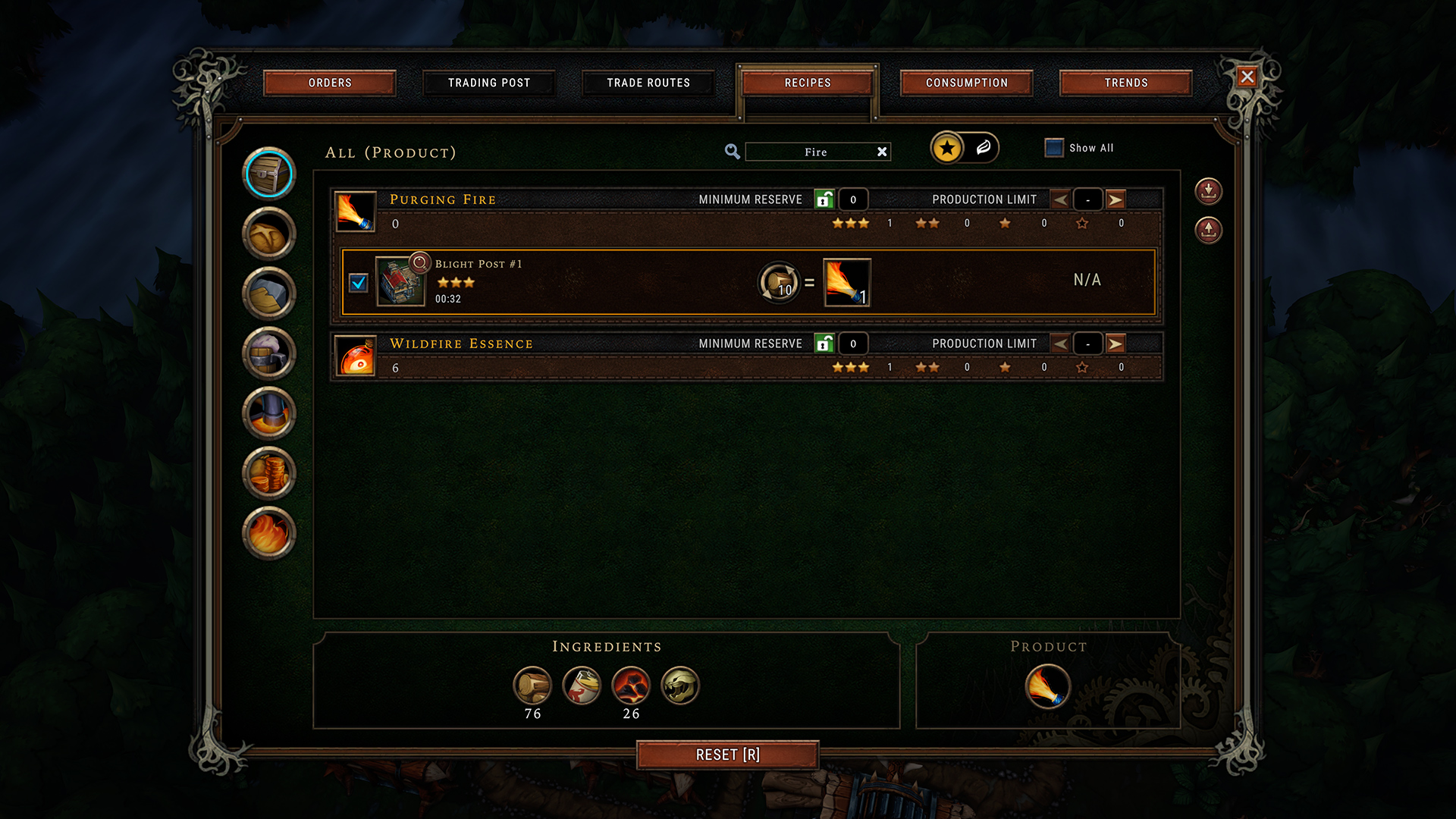
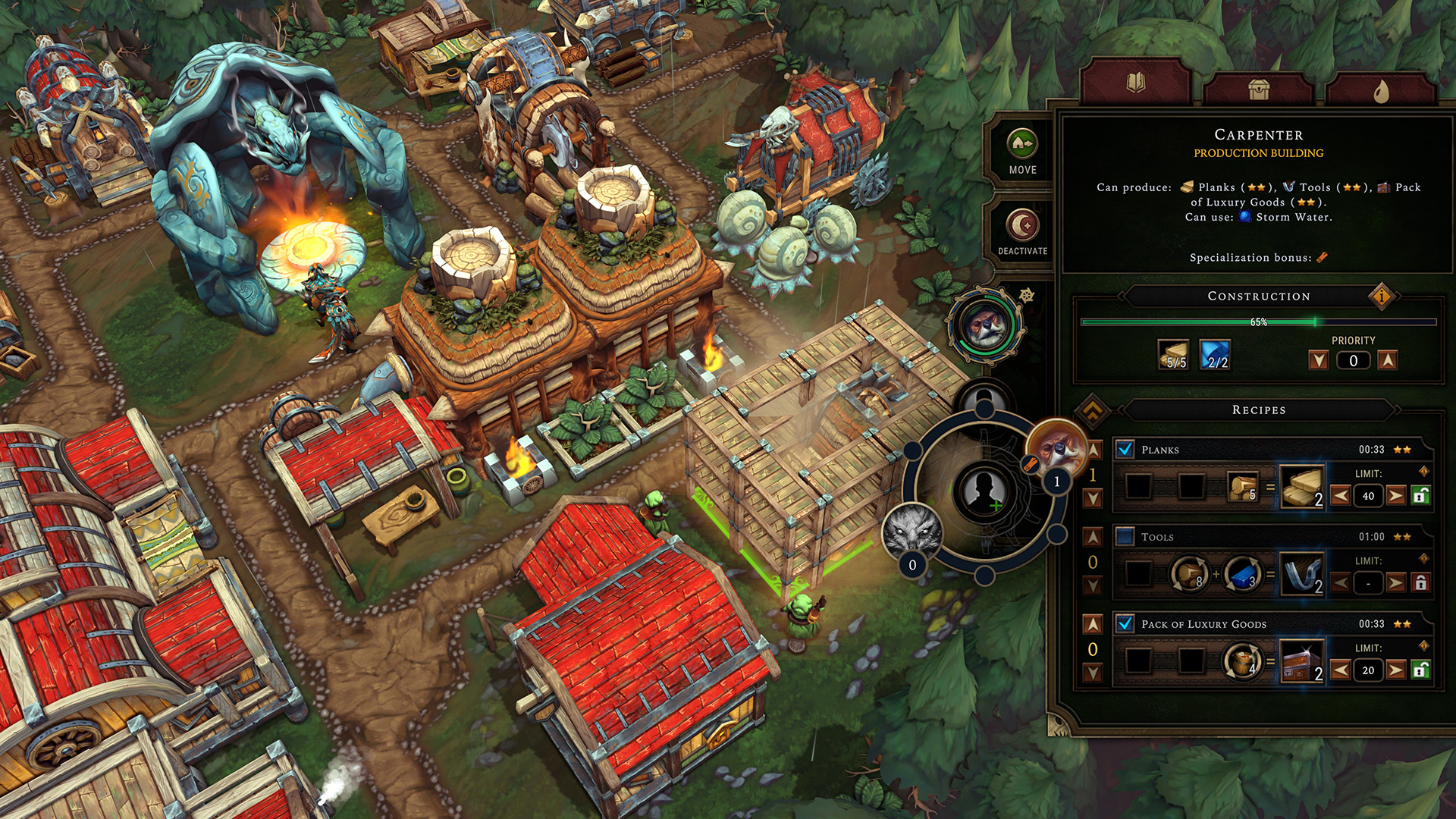
There are also several other improvements to existing systems that were directly inspired by community feedback. For example, the warehouse minimum reserve is no longer automatically remembered between games (you have to turn it on manually in the options menu), you can now mark buildings where you don’t want Blight Fighters to burn cysts, and there is now a red outline around resource slots where a good is missing.
We’ve also replaced some old icons with custom assets (as we do with every patch), updated the visuals of some buildings, changed the lighting in nearly every biome, added new DLC-exclusive music (14 tracks in total), fixed a ton of bugs, and tweaked the game’s localization based on your feedback.
We could go on and on, but we’ll stop here and let you read the huge changelog for yourself. You can also see the new features in action by watching the recording of our developer livestream, where we discussed the major changes and answered questions from the community:
Thank you all for providing feedback, reporting bugs, and giving us suggestions for new content. If you’d like to share your ideas for upcoming updates, here are some useful links:
- Steam Discussions, Discord, Reddit – discuss the game with the community and share your impressions
- Feature Request Tool – suggest specific new features
May the storm be gentle on you,
Eremite Games
FISHING UPDATE 1.4 CHANGELOG
Changes marked with ⚡ were inspired by the community.
Changes marked with 🐸 are related to the Against the Storm: Keepers of the Stone DLC.
New content and features
- ⚡ Added fishing.
- Fishing is a new way of acquiring resources from ponds found in glades.
- To fish, players need a Fishing Hut.
- Fishing Huts work very similarly to camps. There are two types: small and regular. The small one is an essential building, and the regular one needs to be acquired separately (as a blueprint choice, from a trader, or via a wildcard).
- Fishing Huts collect resources from ponds. Similarly to regular resource nodes, there are two sizes of ponds: small (2×2) and large (3×3).
- There are 3 types of ponds:
- Algae Pond – A murky pond covered with algae bloom.
- A small Algae Pond gives 1 Algae and has a 40% chance for Herbs.
- A large Algae Pond gives 2 Algae, has a 50% chance for Herbs, and a 20% chance for Fish.
- Thunderfish Pond – A very common species of eel.
- A small Thunderfish Pond gives 1 Fish and has a 40% chance for Scales.
- A large Thunderfish Pond gives 2 Fish and has a 50% chance for Scales.
- Copperfin Trout Pond – Caught primarily for its durable scales and fish leather.
- A small Copperfin Trout Pond gives 1 Scale and has a 40% chance for Sea Marrow.
- A large Copperfin Trout Pond gives 2 Scales, has a 50% chance for Sea Marrow, and a 30% chance for Fish.
- Algae Pond – A murky pond covered with algae bloom.
- Fishermen don’t collect resources like regular gatherers. They first catch fish and algae in nets, and then transport them directly to a warehouse when the entire pond is depleted. Resources held in nets are not available for production or consumption, they must first be transported to a warehouse.
- Players can decide to reel in a net sooner, but once they do this, the pond is depleted.
- Ponds have a very large number or resource charges in them when compared to other does (60 as opposed to 20 in small ones). The intention here was to create a new type of resource gathering mechanism – a mix of a non-renewable source (just like regular deposits) and a big time investment with a big yield at the end (like in the case of farming).
- Players can use ground bait to double fishing yields.
- Ground bait is made from Packs of Crops. One Pack of Crops equals four pieces of bait. Bait is created in the Fishing Hut, instantly after a fisherman brings a Pack of Crops to the building.
- Players can decide (in the Fishing Hut UI) how ground bait should be used. There are 3 options:
- None – fishermen will never use bait.
- Optional – fishermen will use bait when it’s available.
- Only With Bait – fishermen will not fish when no bait is available.
- ⚡ Added 5 new resources.
- Fish – Plenty of them in the sea. A common food source.
- Obtained in: Small Fishing Hut, Fishing Hut
- Added to recipes: Paste, Pack of Provisions, Pie, Oil, Skewers, Porridge
- Scales – Durable fish skin, richly infused with copper. Used for crafting.
- Obtained in: Small Fishing Hut, Fishing Hut
- Added to recipes: Copper Bar, Dye, Boots, Incense, Waterskins
- Algae – Slimy, tough fibers fished from murky waters. Used for crafting.
- Obtained in: Small Fishing Hut, Fishing Hut
- Added to recipes: Coal, Crystalized Dew, Flour, Fabric, Leather (Ranch), Meat (Ranch)
- Paste – A smooth paste, no chewing required.
- Used by: Humans, Lizards, Frogs
- Produced in: Pantry, Tinctury, Rain Mill, Press
- Ingredients:
- Paste
- Eggs/Fish/Meat
- Boots – Sturdy and waterproof.
- Used by: Lizards, Foxes, Frogs, Harpies
- Produced in: Cobbler, Leatherworker, Toolshop, Weaver
- Ingredients:
- Leather/Scales
- All new resources have also been added to other existing elements of the game – orders, traders, glade events, etc.
- Fish – Plenty of them in the sea. A common food source.
- ⚡ Increased the level cap from 18 to 20.
- ⚡ Added 2 rewards to the upgrade tree in the Smoldering City.
- More Villagers – You gain one additional villager at the start of every settlement.
- Embarkation Bonus: Fishing Hut – You gain a new Embarkation Bonus to choose from when starting a settlement: Fishing Hut.
- As a result of these new additions (from Update 1.4 and the DLC), there are 4 new upgrades available for purchase in the Smoldering City. Some of the rewards mentioned above have been added to existing upgrades, causing some of them to be moved around in the upgrade tree. A detailed description of all the changes can be found below in the Balance section of this changelog.
- ⚡ Added 3 new buildings.
- Small Fishing Hut – A crude version of a normal fishing hut. It’s slower, and can only fish in small ponds.
- Can collect: Fish (T1), Scales (T1), Algae (T1)
- Fishing Hut – An advanced fishing hut. Can fish in large ponds in addition to small ones.
- Can collect: Fish (T2), Scales (T2), Algae (T2)
- Cobbler
- Can produce: Boots (T3), Pack of Luxury Goods (T2), Dye (T1)
- Can use: Clearance Water
- Specialization: tailoring
- Small Fishing Hut – A crude version of a normal fishing hut. It’s slower, and can only fish in small ponds.
- Added 1 Epic Cornerstone, 4 Rare perks, and 2 Uncommon perks.
- Book of Water (Epic, yearly) – All recipes using rainwater have a 5% higher chance of producing extra resources for every 60 Fish, Scales, or Algae produced.
- Wide Nets – (Rare, orders, glade traders, tricker boxes) – More durable and much wider nets. Fishing speed is increased by 25%.
- Fish Scaler (Rare, traders, tricker boxes) – +1 to Scales production. Gain additional Scales every yield (from gathering, farming, fishing, or production).
- Chum Bucket (Rare, traders, tricker boxes) – +1 to Fish production. Gain additional Fish every yield (from gathering, farming, fishing, or production).
- Microfilter Net (Rare, traders, tricker boxes) – +1 to Algae production. Gain additional Algae every yield (from gathering, farming, fishing, or production).
- Shoe Mold (Uncommon, traders, orders, tricker boxes) – +2 to Boots production. Gain additional Boots every yield (from gathering, farming, fishing, or production).
- Steel Grater (Uncommon, orders, glade traders, tricker boxes) – +2 to Paste production. Gain additional Paste every yield (from gathering, farming, fishing, or production).
- Added 5 new Orders.
- Scaling Up
- Objective: deliver 30/40/50 Scales
- Reward: Shoe Mold, 25 Coats, 30 Porridge
- Out Fishing
- Objective: deliver 30/40/50 Fish
- Reward: Viceroy’s Survival Guide, 30 Boots, 4 Parts
- Algal Bloom
- Objective: deliver 30/40/50 Algae
- Reward: Reinforced Needles, 30 Paste, 6 Tools
- Lumps of Coal
- Objective: deliver 20/40/60 Coal, upgrade a mine to level 1/2/3
- Reward: Specialized Mining, 30 Oil, 35 Dye
- Ore Mining
- Objective: deliver 20/40/60 Copper, upgrade a mine to level 1/2/3
- Reward: Steel Drills, 10 Tools, 30 Sea Marrow
- Scaling Up
- Added 3 new Forest Mysteries.
- Bitter Rain (Hostility 2) – A cold, half-frozen sleet is falling from the sky. To prevent it, fulfill the following need: Clothing x1. Villagers without that need fulfilled will suffer the Exhausted effect (-40% movement speed).
- Cold Front (Hostility 3) – The wind is bone-chillingly cold, making every exposed bit of skin sting painfully after just a few moments. To prevent it, fulfill the following needs: Complex Food x1, Clothing x1. Villagers without that need fulfilled will suffer the Distracted effect (20% chance of destroying a yield).
- Cloudburst (Hostility 3) – Even the hardiest villagers need some sort of cover in this weather. To prevent it, fulfill the following needs: Housing x1, Clothing x1. Villagers without that need fulfilled will suffer the Drenched effect (-5 Resolve).
- The old Cloudburst Forest Mystery (the one with a Coats payment) was removed.
- Added a new Leather node to some biomes.
- Water Strider Molt – The chitinous exoskeleton left behind by a juvenile Water Strider.
- Small node: 1 x Leather, 20% chance for Meat
- Large node: 1 x Leather, 100% chance for additional Leather, 40% chance for Meat
- Leather from Water Strider Molts can be harvested using a Harvesters’ Camp.
- The new node can be found in the Marshlands, Scarlet Orchard, and in the Cursed Royal Woodlands.
- Added 2 new needs.
- Paste – This need is fulfilled at the Hearth. It requires Paste.
- Boots – This need is fulfilled at the Hearth. It requires Boots.
- Added 2 new fishing-themed unique glades (one forbidden, one small).
- Added a new haunted ruin – the Haunted Guild House. It becomes the Holy Guild House when rebuilt and has 2 effects instead of 1 in the regular version.
- Added new dialogue to Lori in the Smoldering City.
- ⚡ Added passive effects to all needs.
- To make fulfilling needs more meaningful and to address the Resolve system being too all-or-nothing, we decided to introduce passive bonuses to all needs.
- The bonuses are based on the need category and are applied to Complex Foods, Services, and Clothing. Housing has no additional effect.
- Complex Food – each satisfied need of this category increases a villager’s chance of producing double yields by 5%.
- Services – each satisfied need of this category increases a villager’s chance of producing double yields by 10%.
- Coats – grant an additional +3 to Resolve during the Storm.
- Boots – grant a 15% movement speed increase.
- Adjusted the descriptions of needs and goods according to these changes.
- ⚡ Added two new deeds.
- Renovator – Upgrade any buildings in your settlements 80 times.
- Taking the Bait – Use 500 ground bait in Fishing Huts.
- ⚡ Added a new decoration.
- Big Catch – 1×1 comfort decoration. Unlocked by completing the Taking the Bait deed.
- Added 4 new ghost encounters in the Cursed Royal Woodlands.
Balance
- Removed the Rainwater specialization from Foxes. They now have a Blightrot (Comfort) specialization that is only active when a building has at least one Blightrot Cyst on it.
- Changed the recipe for Coats.
- It now requires Dye or Resin.
- Fabric can be changed to Leather.
- The recipe is a lot faster than before.
- Increased the buy and sell price of Coats to reflect the change in ingredients.
- Changed the requirements for 2 Forest Mysteries.
- Eclipse – this effect no longer requires services x2 to prevent it. Instead, it now requires services x1 and clothing x1.
- Alluring Lights – this effect no longer requires services x2 to prevent it. Instead, it now requires services x1, clothing x1, and complex food x1. It also has a higher difficulty cost, which means it will appear with weaker negative effects or stronger positive effects to offset its harshness.
- Training Gear can now also be made with Leather.
- Changed the Skewer recipe. It now requires 1 less Insect/Meat/Mushroom/Fish/Jerky in all tiers.
- Fabric can no longer be produced with Leather. Algae took its place.
- Leather in the Ranch can no longer be produced with Plant Fiber. Algae took its place.
- Renamed Pigment to Dye.
- Renamed the “clothing” need to “coats”. “Clothing” is now the name of the entire need category with coats and boots in it (similar to Complex Food and Services).
- Reshuffled the needs of all species.
- Humans – Porridge, Pie, Biscuits, Coats, Leisure, Religion, Shelter, Human Housing
- Beavers – Biscuits, Pickled Goods, Coats, Leisure, Education, Luxury, Shelter, Beaver Housing
- Lizards – Jerky, Pie, Skewers, Pickled Goods, Boots, Brawling, Shelter, Lizard Housing
- Harpies – Jerky, Paste, Boots, Coats, Education, Treatment, Shelter, Harpy Housing
- Foxes – Porridge, Skewers, Pickled Goods, Boots, Treatment, Religion, Shelter, Fox Housing
- Rebalanced recipes in multiple production buildings.
- Weaver – removed Pack of Trade Goods (T1), added Boots (T1).
- Toolshop – removed Barrels (T1), added Boots (T2).
- Tinkerer – removed Pack of Building Materials (T2), added Pottery (T2).
- Tinctury – increased the tier of Dye (T2 > T3).
- Tea House – removed Porridge (T2), added Incense (T2).
- Stamping Mill – removed Pottery (T3), added Bricks (T2), increased the tier of Copper Bars (T1 > T2).
- Smelter – removed Biscuits (T1), added Pie (T1).
- Scribe – removed Tools (T1), added Pack of Trade Goods (T2), lowered the tier of Ale (T2 > T1).
- Rain Mill – removed Pack of Building Materials (T1), added Paste (T1).
- Press – removed Pack of Luxury Goods (T1), added Paste (T1).
- Manufactory – removed Pack of Provisions (T2) and Training Gear (T2), added Fabric (T2) and Barrels (T2).
- Leatherworker – removed Dye (T2) and Fabric (T2), added Boots (T2) and Training Gear (T1).
- Grill – removed Ale (T1), added Paste (T2).
- Furnace – removed Bricks (T2), added Skewers (T2).
- Druid’s Hut – removed Incense (T1), added Tea (T2).
- Distillery – removed Porridge (T2), Barrels (T2), and Wine (T2), added Pickled Goods (T2), Ale (T2), and Incense (T2).
- Cooperage – removed Tea (T1), added Pack of Luxury Goods (T1).
- Clothier – removed Scrolls (T1), added Pack of Building Materials (T2).
- Cellar – removed Jerky (T1), added Pack of Provisions (T1), increased the tier of Pickled Goods (T1 > T2).
- Brick Oven – removed Pie (T3), added Biscuits (T3), increased the tier of Incense (T1 > T2).
- Brewery – removed Pickled Goods (T1), added Porridge (T2).
- Artisan – removed Pack of Luxury Goods (T2), added Scrolls (T2).
- Apothecary – removed Biscuits (T2) and Incense (T2), added Porridge (T2) and Jerky (T2).
- Field Kitchen – removed Jerky and Porridge, added Paste and Skewers instead.
- Rebalanced needs and effects in some service buildings.
- Clan Hall – removed Religion, added a new effect (active when there are 2 workers).
- Carnivorous Tradition – Lizard tribes have a long tradition of both animal husbandry and meat preparation. All meat-based complex foods (jerky, skewers, pies, paste) give 2 more Resolve.
- 🐸 Forum – removed Leisure and Education, added Brawling and Luxury. Changed the Public Lectures effect to Public Performances.
- Guild House – added Education. Moved the “Guild House” effect (active when there is 1 worker) to the Holy variant of the service building.
- Market – removed Luxury, added Leisure. Changed the Land of Luxury effect in the Holy Market to “Ale and Hearty”. It also now scales off of Leisure instead of Luxury.
- Tea Doctor – removed Brawling, added Religion.
- Clan Hall – removed Religion, added a new effect (active when there are 2 workers).
- Changed which buildings are locked behind which species.
- Tinctury is now locked behind Beavers.
- Scribe is now locked behind Beavers.
- Leatherworker is now locked behind Lizards.
- Cooperage is no longer locked behind Harpies.
- Artisan is now locked behind Harpies.
- Apothecary is now locked behind Harpies.
- 🐸 Forum is now locked behind Frogs.
- Rebalanced specialization tags in buildings.
- Stamping Mill – added the Masonry specialization tag.
- Stonecutter’s Camp – added the Masonry specialization tag.
- Kiln – added the Masonry specialization tag.
- Clay Pit – added the Masonry specialization tag, removed the Rainwater specialization tag.
- Brickyard – added the Masonry specialization tag, removed the Rainwater specialization tag.
- Cooperage – removed the Rainwater specialization tag.
- Alchemist’s Hut – removed the Rainwater specialization tag.
- Finesmith – removed the Rainwater specialization tag.
- Alchemist’s Hut – removed the Rainwater specialization tag.
- Greenhouse – removed the Rainwater specialization tag.
- Rainpunk Foundry – removed the Warmth specialization tag.
- Bath House – added the Rainwater specialization tag.
- 🐸 Forum – removed the Brewing specialization tag.
- Rebalanced several Orders.
- Aid for the Fox Pack – this order no longer requires players to deliver rainwater. Instead, it requires discovering glades.
- Aiding the Flock – this order no longer requires players to deliver Packs of Building Materials and Packs of Crops. Instead, it requires delivering Boots and Coats.
- Aid For the Beaver Clan – removed the “produce Wood in Woodcutters Camp” objective.
- Cyst Cultivation – removed Jerky from rewards, added Paste.
- Joyful Foxes – removed Tools from rewards, added Boots.
- Speedy Real Estate – removed Tools from rewards, added Boots.
- Shelters – removed Berries from rewards, added Fish.
- Happy Harpies – removed the Bigger Pans perk from rewards, added the Steel Grater perk.
- More Houses – removed Vegetables from rewards, added Fish.
- Human Influx – removed Pie from rewards, added Porridge.
- Harpy Population – removed Biscuits from rewards, added Paste.
- Stacking Amber – removed Reeds from rewards, added Scales.
- Outposts – removed Tools from rewards, added Boots.
- Harpy Colony – removed Biscuits from rewards, added Paste.
- Good Friends – removed Tools from rewards, added Boots.
- 🐸 The Forum – changed the objective from delivering Scrolls and Ale to Wine and Training Gear. This order is now locked behind Frogs.
- Bloody Sacrifices – this order no longer requires players to have the Butcher building. Instead, it requires players to fulfill needs from the complex food category. The order was also renamed to “Feast”.
- Happy Brewing – this order no longer requires players to have the Brewery building. Instead, it requires players to fulfill needs from the service category. Removed the Tavern blueprint reward and added the Repurposed Clay perk instead.
- Workshop – this order no longer requires players to have the Workshop building. Instead, it requires players to upgrade the Geyser Pump. The order was also renamed to “Water Industry”.
- Dirty Work – this order has been removed from the roster.
- Reshuffled a lot of level up rewards.
- Level 1 – added Butcher, removed Leatherworker.
- Level 2 – added Fishing Hut, removed Crowded Houses.
- Level 3 – added Smelter, removed Scribe.
- Level 4 – added Stamping Mill and Leatherworker, removed Rebellious Spirit and Safe Haven.
- Level 5 – added Artisan, Apothecary, and Harpy House. Removed Cooperage, Smelter, and Urban Planning.
- Level 6 – added Granary and Druid’s Hut, removed Press and Artisan.
- Level 7 – added Press, Cooperage, and Book of Water. Removed Explorer’s Lodge, Tinkerer, and Ranch.
- Level 8 – added Manufactory and Ranch, removed Apothecary and Grove.
- Level 9 – added Foxes, Tea House, Tea Doctor, and Fox House. Removed Vliss Greybone, Toolshop, Brick Oven, and Grill.
- Level 10 – added Grove and Vliss Greybone, removed Foxes and Forum.
- Level 11 – added Tinkerer, Brick Oven, Rebellious Spirit, and Moldy Grain Seeds. Removed Tinctury, Butcher, Tea House, Tea Doctor, and Lost Supplies.
- Level 12 – added Scribe and Toolshop, removed Sir Renwald Redmane and Granary.
- Level 13 – added Frogs (🐸), Forum (🐸), Cannery (🐸), and essential Frog House (🐸). Removed Furnace, Manufactory, Tinkerer, and Bed and Breakfast.
- Level 14 – added Sir Renwald Redmane, Pantry (🐸), and Urban Planning. Removed Workshop, Stamping Mill, and Royal Guard Training.
- Level 15 – added Workshop and Cobbler, removed Clay Pit and Greenhouse.
- Level 16 – added Clay Pit, Greenhouse, and Frequent Patrols. Removed Xiadani Stormfeather, Advanced Rain Collector, and Queen’s Gift.
- Level 17 – added Explorer’s Lodge, Grill, and Queen’s Gift. Removed Free Samples, Improvised Tools, Frequent Patrols, and Reckless Plunder.
- Level 18 – added Xiadani Stormfeather and Advanced Rain Collector, removed Prosperous Settlement and Dual Carriage System.
- Level 19 – added Dual Carriage System, Prosperous Settlement, Royal Guard Training Bed and Breakfast, and Reckless Plunder.
- Level 20 – added Free Samples, Improvised Tools, Safe Haven, Crowded Houses.
- Reshuffled several Smoldering City upgrades.
- Dim Square Level 10 – moved to level 19, adjusted cost according to level increase.
- 🐸 Brass Forge Level 8 – added Frog Starting Ability unlock, removed Parts Embarkation Bonus. Moved to level 13, adjusted cost according to level decrease.
- Brass Forge Level 9 – added Parts Embarkation Bonus, removed Worker Capacity bonus. Moved to level 14, adjusted cost according to level decrease.
- 🐸 Brass Forge Level 10 – added Frog House Upgrade unlock, removed Global Building Storage increase. Moved to level 15, adjusted cost according to level decrease.
- Brass Forge Level 11 – added Global Building Storage increase, removed Blight Post upgrades. Moved to level 17, adjusted cost according to level decrease.
- Brass Forge Level 12 – new upgrade. Gives Worker Capacity bonus and +2% Global production speed. Purchasable at level 19.
- Pioneer’s Gate Level 5 – moved to level 19, adjusted cost according to level increase.
- Obsidian Archive Level 18 – added Blight Post upgrades, removed +30s Grace Period.
- Obsidian Archive Level 19 – new upgrade. Gives +30s Grace Period and -2% Impatience Rate. Purchasable at level 19.
- Obsidian Archive Level 20 – new upgrade. Gives +1 villager at settlement start and -2% Impatience Rate. Purchasable at level 20.
- Monastery of the Vigilant Flame Level 7 – moved to level 20, adjusted cost according to level increase.
- First Dawn Company Headquarters Level 13 – new upgrade. Gives Fishing Hut Embarkation Bonus and +1% chance for bonus yields. Purchasable at level 20.
- These changes will also affect the Queen’s Hand Trial mode, as the drafted upgrades will be taken directly from the original upgrade tree. Because of this, some of you may see a known issue immediately after the update where one upgrade option in the Citadel has a different tier/price than the others (due to the reshuffling). Subsequent upgrade drafts should all be in the correct order.
- Added new resources to all biomes.
- Royal Woodlands – Scales.
- Scarlet Orchard – Fish, Leather.
- Coral Forest – Scales.
- Marshlands – Algae, Leather.
- Cursed Royal Woodlands – Fish, Leather.
- Sealed Forest – Scales, Algae.
- Slightly adjusted the generation rates of some resource nodes in several biomes (for example: stone/clay and plant fiber/reed nodes now have a slightly higher chance of spawning in the Marshland to compensate for the bigger pool of possible resources).
- Changed the stone deposit in the Marshlands. It’s now an “Overgrown Stone Deposit” which has a 30% chance for Algae as a secondary resource (as opposed to Roots from a regular stone deposit).
- Rebalanced geyser generation.
- Slightly increased the number of glades that can spawn a rainwater geyser.
- Slightly decreased the spawn rate of Drizzle Water geysers in small glades.
- Slightly increased the spawn rate of Clearance Water geysers in small glades.
- Evened out the spawn rates of all three types of rainwater geysers in Dangerous Glades.
- Slightly increased the spawn rate of Storm Water geysers in Forbidden Glades.
- Slightly lowered the spawn rate of Clearance Water geysers in Forbidden Glades.
- Slightly increased the buy and sell price of Coal.
- Slightly increased the buy and sell price of Copper Bars.
- Limited the number of Trading Posts per map to 1. After building your first Trading Post, you won’t be able to put down another.
- Renamed the Camps building category to Resource Gathering.
- Updated building categories for multiple buildings to better reflect their role and recipes.
- Mine – changed category from Industry to Resource Gathering.
- Advanced Rain Collector – changed category from Industry to Resource Gathering.
- Rain Collector – changed category from Industry to Resource Gathering.
- Apothecary – changed category from Industry to Food Production.
- Brick Oven – changed category from Food Production to Industry.
- Furnace – changed category from Industry to Food Production.
- Rain Mill – changed category from Industry to Food Production.
- Changed the type of rainwater used in engines for several buildings.
- Apothecary – now uses Drizzle Water instead of Clearance Water.
- Brick Oven – now uses Clearance Water instead of Drizzle Water.
- Furnace – now uses Drizzle Water instead of Storm Water.
- The Master Blueprint Cornerstone now also works with Fishing Huts.
- Added Scales, Fish, Boots, Paste, Algae, and Dye to the pool of random Embarkation Goods.
- Increased the average amount of resources given to the player for salvaging ruins.
- Added new resources to the reward pool for salvaging ruins to improve the content diversity in this area of the game.
- Removed the Secure Trail Cornerstone from the game.
- Changed the order of some buildings in the build menu.
- Rebalanced World Map generation values.
- Drastically reduced the number of Royal Woodlands tiles. It’s still the dominant biome, but should only appear slightly more often than other biomes.
- Overall, all biomes except the Cursed Royal Woodlands now have a very similar chance of spawning (with only a slight bias toward the Royal Woodlands).
- Added the Clay Pit and Greenhouse to the pool of ruins that can spawn in glades.
- ⚡ Removed basic and species specific housing from the pool of ruins that can spawn in glades (the only exception here are the haunted version of these ruins).
- ⚡ Removed the Small Warehouse from the generic ruins pool. It can now only appear as part of special glades.
- ⚡ Changed how the Overexploitation Cornerstone works. It no longer spawns a Blightrot Cyst for every depleted node, but for every 40 node charges used.
- ⚡ Moving houses no longer costs resources.
- ⚡ Changed how the Drying Boards perk works. It now increases the time between breaks for villagers under the effect of Coats.
- ⚡ Production multiplying effects are no longer calculated only at the start of the production cycle.
- ⚡ Buffed the Clay Pit.
- It now requires less rainwater to produce goods.
- Rain Engines can now be installed in the Clay Pit.
- The Clay Pit can now produce Resin.
- ⚡ The Haunted Forest World Map modifier can no longer spawn near the Forbidden Lands and the Dangerous Lands modifier.
- ⚡ Rebalanced some Seal objectives.
- Essence of Corruption no longer requires using rainwater and burning cysts, and instead asks players to burn a certain number of Cysts within a year.
- Fire Essence requires a bit less Resolve than before.
- Mortal Blood requires 1 less Reputation point from Resolve.
- ⚡ Added a new tier of difficulty for Seal objectives. The Titanium and Adamantine Seal now have slightly harder objectives compared to lower Seals.
- This is mostly a numerical change with few exceptions (like Queen’s Feathers requiring the fulfillment of at least one need from all 3 categories instead of just 2).
- ⚡ Calling a trader immediately will now always reduce the arrival time to 30 seconds or less.
UX/UI improvements
- ⚡ Added Glade Events to the in-game Encyclopedia.
- Glade event entries are initially locked. To unlock an event in the encyclopedia, you must first complete it at least once.
- ⚡ Added Purging Fire to the Recipes Panel.
- ⚡ Workers can now be assigned to unfinished buildings. When a worker is assigned to a construction site, they will act as a builder first, and then work there as usual after the building is finished.
- ⚡ Blight Fighters can now take goods from storages of nearby buildings.
- ⚡ Builders can now take goods from storages of nearby buildings.
- ⚡ Farmers can now build farm fields if there are unconstructed fields within the range of the farm they are assigned to.
- ⚡ Clicking on a need icon in the Consumption Control panel will open the Recipes Panel and search for the item used to fulfill a given need.
- ⚡ The progress of a break is now shown on the worker slot. When a villager goes on a break, the worker slot fills up just as it does during production.
- ⚡ Scouts now have a separate action tooltip when going to a glade event.
- ⚡ Villager and cart panels now show the status of a given worker/cart (idling, producing, going to a building, etc.).
- ⚡ Warehouse minimum reserve is no longer saved between games by default. It now has to manually be turned on in the Options menu.
- ⚡ Added a bonus preview to the Blight Pruner Cornerstone tooltip.
- ⚡ Added an option to opt out of rewards given to players after their account has been closed due to an update.
- ⚡ Added a lock icon for goods with a minimum reserve limit in production buildings when selecting recipe alternatives. There is also a tooltip when hovering over the lock icon.
- ⚡ Minimum reserve limits can now also be set in the Recipes Panel.
- ⚡ Firekeeper abilities can now be previewed when hovering over a portrait in the worker assignment radial menu in the Ancient Hearth.
- ⚡ Added a toggle to the Blightrot Overlay that allows players to exclude a particular building from being cleansed by Blight Fighters.
- ⚡ The Seal Contract section of the End Cycle popup has been updated to make the role of this system clearer.
- ⚡ The upgrade screen in the Smoldering City will now automatically scroll to the highest upgrade acquired instead of the current level.
- ⚡ Added a toggle to ignore diagonal trees when marking glades with the “ignore glade edges” modifier (Ctrl).
- ⚡ Flawless buildings the player owns will now be displayed in tooltips as sinks/sources for resources.
- ⚡ Changed the descriptions of all advanced houses to make it clearer that they fulfill the need for species housing.
- ⚡ Changed the wording in the Decay effect to indicate the maximum number of Blood Flowers it can spawn.
- ⚡ The in-game encyclopedia now displays information about buildings locked behind a given species (in the “Species” tab and in individual building entries in the “Buildings” tab).
- ⚡ Changed the wording of the “Decadent” tooltip in the species encyclopedia page to make it easier to understand.
- ⚡ Added missing keybinds to the “Useful Shortcuts” entry in the in-game encyclopedia.
- Added a new entry to the in-game encyclopedia about fishing.
- Added “learn more” alerts in the second and third tutorial (with info about Blightrot, Rainpunk, Hostility).
- Resource selectors in Glade Events now have a red outline when a selected good is not available (similar to how it works in production buildings).
- Changed the layout of the upgrade tab in all buildings with upgrades to make it more compact and easier to read.
- Fixed an issue with incorrect text scaling in the in-game encyclopedia.
- Changed the wording in the objective and description of orders that require players to upgrade buildings (to clearly state the number of buildings that should be upgraded).
- Changed the descriptions of all service needs to clearly indicate the items that are required to fulfill them.
- Renamed all perks with “boots” in the name and changed their icons to avoid confusion with the new item.
- Several alert messages have been shortened to better fit the UI.
- Changed the wording in the Regrowth Forest Mystery to avoid confusion.
- Added an alert when a stone deposit spawns in maps with the Petrified Necropolis modifier.
- Increased the size of the construction tooltip that lists all required goods when placing a building.
- Changed the order of resources (for both the player and trader) in the trade window so that they are grouped by type.
- Adjusted the UI layout of the Hearth panel to make room for a new resource to sacrifice (Algae in the Coastal Grove).
- Changed the wording of order objectives requiring the player to fulfill the needs of a certain category to make them clearer.
- Changed how stacking effects are displayed in the villager UI. Instead of just a number, they now have an “x” in front.
- Reputation and Impatience Bar tooltips now show the current and maximum values.
- Farmers will stop harvesting a given crop if the resource is disabled in the farm’s panel.
Bug fixes
- ⚡ Fixed a bug where villagers would restart their animation after the game was unpaused.
- ⚡ Fixed a rare bug that would corrupt the game save if it was created at the exact moment a villager was calculating his next action.
- ⚡ Fixed a bug where workers would pop out of a building for a split second after every finished production cycle.
- ⚡ Fixed a bug that caused scouts to have incorrect animations when solving the Rivel Kelpie glade event.
- ⚡ Fixed a bug that made it possible to play the Sealed Forest biome in Training Expeditions.
- ⚡ Fixed a bug where the Flawless Brewery would have incorrect recipe yields.
- ⚡ Fixed a bug where Resolve numbers would be displayed incorrectly when hovering over the favoring button while a new species is added to the settlement.
- ⚡ Fixed a bug where the Safe Haven Cornerstone wouldn’t update its status if a hearth was upgraded while the game was paused.
- ⚡ Fixed a bug where the World Map tutorial would sometimes break after the second tutorial game was force closed after an update.
- ⚡ Fixed a bug where species houses were essential when replaying tutorials.
- ⚡ Fixed a bug where the “no rainwater” icon was displayed above inactive buildings.
- ⚡ Fixed a bug where the highlighted area in the trends panel was too small.
- ⚡ Fixed a bug where the Priestess avatar would not follow the Forsaken Altar when it was moved.
- ⚡ Fixed a bug where the tooltip area for species counters was too large.
- ⚡ Fixed a typo in the Russian description of the Protected Trade Cornerstone.
- ⚡ Fixed a bug that was causing players to get the Overexploitation Cornerstone in games without Blightrot.
- ⚡ Fixed a bug where the Prosperous Settlement Cornerstone was increasing the work speed of the glade event instead of slowing it down.
- ⚡ Fixed a bug where the Forge Trip Hammer Cornerstone would be offered to players who already own the Stormforged version of it.
- ⚡ Fixed a bug that was causing Packs of Crops to appear twice in the Ruined Granary rewards section.
- ⚡ Fixed a typo in the minecart upgrade description in the mine.
- ⚡ Fixed a bug that sometimes displayed the wrong resource when searching for something in the Recipes Panel.
- ⚡ Fixed a bug where highlighting text in the Recipe Panel would make the selected text unreadable.
- ⚡ Fixed a bug where the ingredient radial menu would stay on the screen after closing the encyclopedia.
- ⚡ Fixed a bug where ingredients listed in a production building would overlap if there were more than 8 at the same time.
- ⚡ Fixed a bug where perks and orders based on house or mine upgrades were appearing for players who haven’t yet unlocked the feature.
- ⚡ Fixed a bug where the Forge Trip Hammer Cornerstone would be offered to the player even if they didn’t have a Smithy.
- ⚡ Fixed a bug where some initial glade layouts with ruins were spawning service buildings too far away from the Hearth.
- ⚡ Fixed a bug where the standing progress bar in the Trade Routes panel would continue to fill even after the maximum level was reached.
- ⚡ Fixed a bug where in-progress resource deliveries from haulers would not be canceled after a recipe’s ingredients were disabled and the “auto-return” option was enabled.
- ⚡ Fixed a bug where the worker selection UI would not update if a new villager joined the settlement while it was active.
- ⚡ Fixed incorrect name translations (for traders, NPCs, etc.) in Simplified Chinese.
- ⚡ Fixed a number of typos in the Japanese version of the game (Fedora Hat Cornerstone, sacrifice effects, Hearth level description, Royal Woodlands description, trade route orders, Overexploitation Cornerstone)..
- ⚡ Fixed a typo in the Spanish (Latin America) version of the Overexploitation Cornerstone.
- ⚡ Fixed a typo in the Polish version of the Prosperous Archaeology Cornerstone.
- ⚡ Fixed a typo in the Russian version of the Prosperous Settlement Cornerstone.
- Fixed a bug where table headers would remain in the Warehouse panel after switching from list view to grid view.
- Fixed an issue where the “learn more” alerts would not appear in some cases.
- Fixed a bug where clicking the same building twice would sometimes block the ESC menu from appearing.
- Fixed a bug where some glades would spawn the wrong amount of ore.
- Fixed a bug where some biomes would have lower spawn rates for some unique small glades.
- Fixed a rare bug where building category tooltips were displayed incorrectly.
- Fixed a bug that prevented the Supply Thy Neighbor order to be drafted.
- Fixed a bug that caused Holy variants of some service buildings to be displayed in need tooltips (even if the player didn’t own them).
- Fixed a bug where the Chaos resolve effect from the Harmony Altar Glade Event had an incorrect icon.
Other
- ⚡ Villagers charmed by the Kelpie glade event will now go to the Kelpie and stand around it, hypnotized.
- Updated the Kelpie Charm description to correctly reflect the behavior of charmed villagers.
- Changed the visual appearance of some buildings.
- Clay Pit
- Apothecary
- Brickyard
- Press
- Scribe
- Stamping Mill
- Forum
- Replaced a few icons with new custom assets.
- Kelpie’s Charm
- Watery Grave
- Voice of the Sealed Ones
- Updated a few old sound effects that are played after selecting an object.
- Noxious Machinery
- Press
- Clay Pit
- Tweaked the lighting in all biomes.
- Added a setting in the Options menu to change menu skins.
- Supporter Pack was updated with all the new music tracks from the DLC, a Frog Villager portrait, and the Keepers of the Stone wallpaper.
The current game version is 1.4.4.
SETTLEMENT SAVES & LEGACY BRANCHES INFORMATION
As with all major updates, numerous systemic changes require us to close the ongoing settlements to avoid potential issues. As compensation, you’ll receive extra Citadel Resources and Royal Resupply. On a community request, we also added an option to decline that reward.
(Steam only) However, for those of you who weren’t able to finish their settlements and would very much like to do so, we also prepared a separate Legacy Branch 1.3 where we’ll keep the previous version available indefinitely.
If you want to finish your current settlement, follow the instructions below prior to playing with the new Fishing Update (1.4).
- Open Steam
- Right-click on Against the Storm in your library
- Select Properties
- Go to the BETAS tab
- Enter the access code in the “Private Betas” section. The access code is: LegacyBranchPreFrogs
- Click on “Check code”
- Choose “legacy_branch_1.3” from the drop-down list
- Wait for the game to update the files
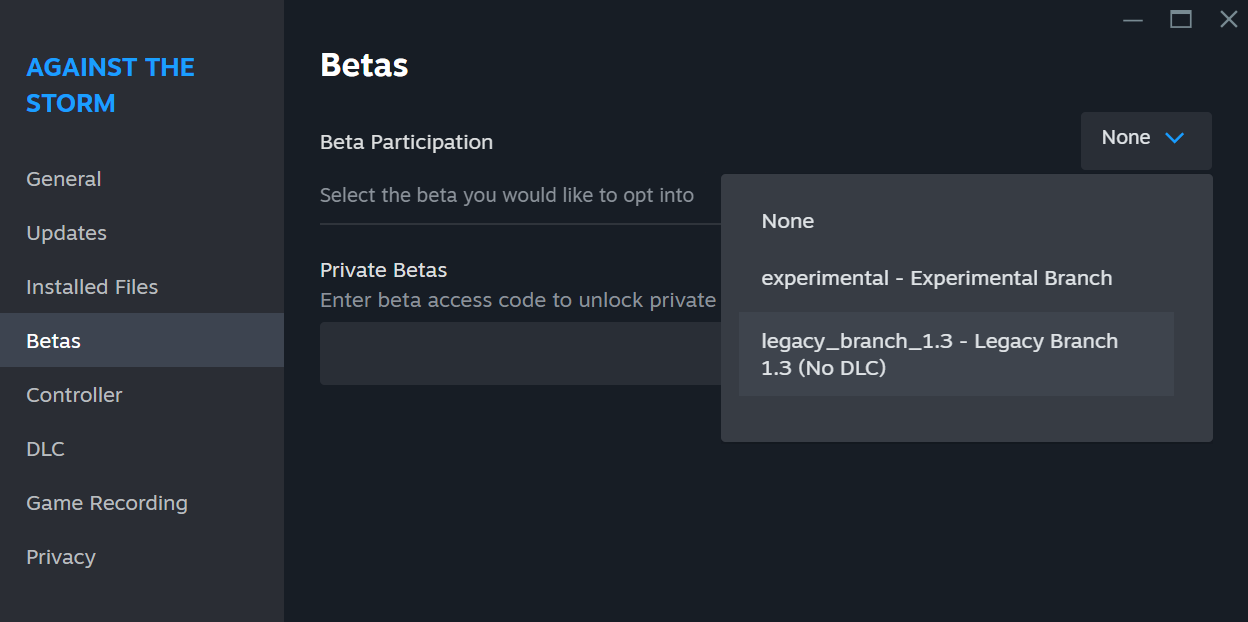
Once you finish the settlement on the Legacy Branch 1.3, follow the steps above, but select “None” to return to the main branch.
Legacy Branch 1.3
Against the Storm’s Fishing Update 1.4 introduced a vast range of new content, balance changes, and improvements. Together with Keepers of the Stone DLC, it is the largest content drop in the game’s history.
With such a high number of changes, it may require re-learning the recipes, changing strategies, or simply getting used to the new balance. Due to this, we know that some of you may be desperate to play the version you knew and enjoyed for so long.
We always recommend playing on the latest public version as we continuously ensure it’s in the best technical state. However, if you prefer, you can download and play the “pre-Frogs” version 1.3.5 (Legacy Branch 1.3) using Steam’s Betas branching functionality.
Please carefully read the guide below to learn more about switching branches and potential issues that may occur:
ENJOY AND HAVE FUN
That’s all for today, folks! We’re excited you can finally welcome Frogs to your settlements. Ever since we first introduced them in the community vote back in February 2023, we wanted to do them justice and add them to the game. And now, finally, they are here!
CONTINUE READING...
Nightwatchers DLC launches on July 31st!
Survival demands sacrifice. Command justice with Bats, settle two new biomes, and delve into new content. Nightwatchers DLC releases July...
Against the Storm is coming to consoles!
Greetings, Viceroys! We’re happy to announce that Against the Storm will launch on consoles on June 26th! We partnered with QLOC - game porting...
Quality of Life Update (1.7) now available!
Greetings, Viceroys! We’re back with another Against the Storm update—one that, hopefully, will make your experience with the game even more...


